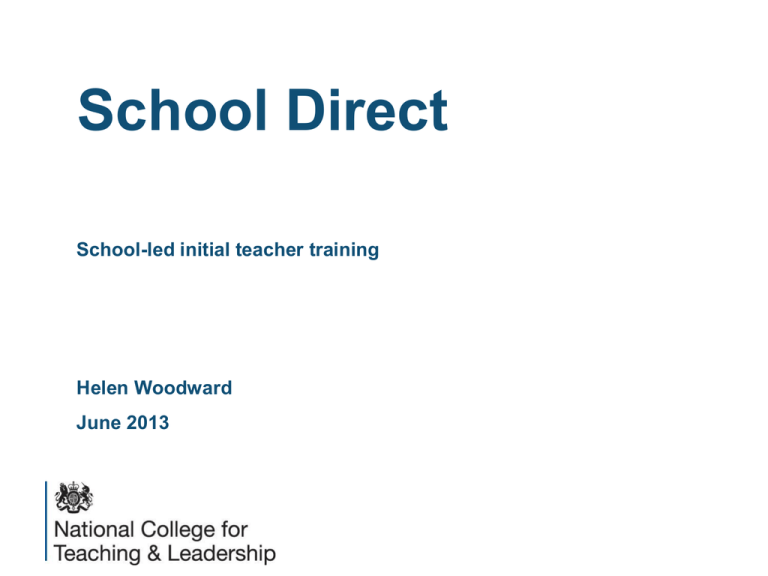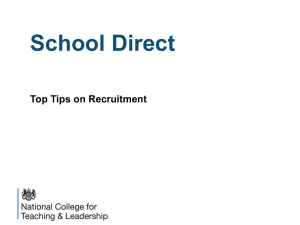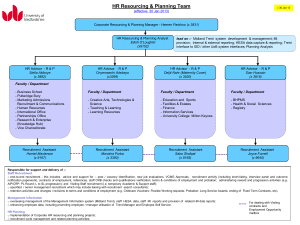MSA School Direct National College for Teaching and Leadership
advertisement

School Direct School-led initial teacher training Helen Woodward June 2013 Myths and truths… What do you know / what have you heard about school direct? Key questions: Whose responsibility is it to train teachers? Who has the expertise? About School Direct “School Direct is the new way of training teachers which puts schools, the employers, the customers, at the heart of the process. With School Direct, schools can directly request training places. Schools select the provider of teacher training they want to work with, whether it is a university or a school-based SCITT. They agree the content and focus of the course depending on their needs and they can negotiate directly with the provider on how the money for training should be divided. Most importantly they can choose and recruit the candidate they want – the candidate their school needs.” Charlie Taylor, CEO, National College for Teaching & Leadership School Direct enables you to… …play a lead role in growing and developing your own staff. …strategically plan and overcome local recruitment needs. …decide who you want to recruit and train. …take more control of initial teacher training. …deploy and employ across your local network of schools. Your vision for ITT: ‘I want school direct because I want to be 100% confident in every NQT appointment I make and move from good to outstanding.’ (Brendan Loughran, Head Teacher, Darwen Aldridge Academy) Benefits for trainees “School Direct offers the experience of a school from the start, making teaching a far less daunting prospect.” “You are able to embed yourself into the school more than you would on a traditional placement, and therefore build stronger relationships with pupils and teachers that will help to improve your teaching.” “This sense of belonging is something which underpins the School Direct experience. As a School Direct trainee I have access to the full spectrum of school life. At a basic level, this means that I attend meetings, assist with a form, perform duties, and teach classes. On a training level, however, this means that I have access to a whole range of opportunities for professional development which I can use to enhance my training experience and my future employability.” School Direct has two types of training places Tuition fee Salaried Trainee is not employed by the school. Trainee pays tuition fees (up to £9,000) to the selected ITT Provider (ITTP). School/ITTP decide how to divide funding – as per roles and responsibilities. Eligible trainees can access ITT bursaries, scholarships and student finance. For career changers with at least three years’ work experience. Trainee is employed by one of the schools in the partnership – if a maintained school, the salary is a minimum of point 1 of the unqualified teacher scale (about £16k + on-costs) – no requirement to be supernumerary. NCTL pay the school a contribution towards training costs and salary. School/ITTP decide how to divide funding – part of partnership agreement. Trainees cannot access bursaries, scholarships or student finance. Funding – 2013/14 (2014/15 TBC) 2013/14 bursaries, scholarships and school direct (salaried) funding Physics, Modern Primary Other priority Computer chemistry, languages maths secondary science 1 2 maths specialist and primary st Bursary - 1 £20,000 £20,000 £11,000 £9000 £9000 Bursary - 2.1 £15,000 £15,000 £6000 £4000 £4000 Bursary - 2.2 £12,000 £12,000 £0 £0 £0 Scholarship See note N/A N/A N/A See note below below 25% premium paid on the above bursaries/scholarships to school direct FSM premium trainees whose training is based in a school where more than 35% of pupils are eligible for free school meals School direct (salaried)3 – contribution paid to school/ITT provider School direct (salaried) FSM premium £19,000 £19,000 £16,000 £14,000 £14,000 10% addition paid on the above funding for school direct (salaried) trainees whose training is based in a school where more than 35% of pupils are eligible for free school meals Other priority secondary: English, Geography, History, Computer Science, Greek, Latin, music, biology, PE Do you want to join an existing partnership? Joining a partnership provides greater opportunities to share expertise, meet the employment expectation, achieve more efficient management of a School Direct programme, as well as economies of scale in negotiations with accredited teacher training providers. Lead School Role The Lead School on behalf of all partner schools: Completes the registration on behalf of all partner schools. Leads development of the partnership agreement across schools. Negotiates the partnership agreement (including division of funding, roles and responsibilities and programme design) with the initial teacher training provider(s). Submits the ‘request for places’ form on behalf of all partner schools. Receives all allocations of places from the NCTL. Leads on recruitment and “Because of the level of involvement selection, including liaising with the ITTP on managing we have in the planning and delivery applications. of the programme, everyone in the Is responsible for all reporting and network is incredibly excited about ensuring recruitment is on target. the potential of our School Direct programme to create the best possible NQT’s for our schools.” ARK Schools, London Partnership agreements The following essential areas should be agreed between the Lead School and initial teacher training provider(s): Do you want to award a PGCE or QTS only? How is funding split between schools and providers? What should be the process, timelines and deadlines for recruitment and selection of trainees; school and provider’s lead roles and responsibilities, process for resolving differences? At what stage in the process do you expect trainees to have completed their skills tests? How much school experience you expect potential applicants to have before applying? Is there ITTP support for marketing and recruitment (incl. events)? Which elements of the training will be delivered by the school and which by the ITTP, including arrangements for assessment, quality assurance, subject knowledge training, mentoring/mentor training? School Direct schedule 2014/15 When What Key activities February 2013 onwards Registration for 2014/15 • • • Assess how many places you will be requesting Agree roles and responsibilities across schools Consider ITT Provider options June – September 2013 Requesting places • Agree ITT provider including division of funding and partnership agreement Plan and schedule recruitment and selection dates Prepare information about your School Direct programme and schools (entry profile) • • October 2013 Receiving places • • Communicate to all schools involved Finalise your information November 2013 UCAS - Teacher Training opens • Promote your places November 2013 – August 2014 Recruit trainees • Manage applications and decision making process September 2014 – June 2015 Training • Co-ordinate training programme September 2015 Employment TBC Audit and evaluation Timelines Submit a short registration form. Submit a request for places using the log-in details provided following registration. Provide details on the type of School Direct places (salaried or tuition fee), phase and number of places being requested on behalf of the partnership. State which accredited ITT provider the school will work with. The ITT provider will need to ratify the request for places before submission, to ensure that they are able to deliver in partnership with you. Schools are required to use the UCAS - Teacher Training application system to advertise School Direct places and manage their applications with a 40 day turnaround. Conduct a high quality, open and transparent recruitment process, which will be subject to inspection by Ofsted. Partnership planning (1/2) You may want to consider the following tips for planning partnership work across schools: Start early. Think about which schools to work with and why – consider diversity of placements to create opportunities for trainees; cross phase, special schools, pupil referral units, urban and rural schools. Clarify what minimum entry requirements you/your provider may have on top of the ITT criteria e.g. academic qualifications, school experience. Be clear about your shared vision and who is doing what – use this to decide which provider you want to work with. Plan together to the last detail. Partnership planning (2/2) Know what you want to do and achieve well in advance. Meet frequently. Agree costs and shared resources. Monitor, review and adjust regularly. Communicate regularly with everyone. “Build a larger alliance and get Heads to develop a new vision for how they find NQTs and why training their own (with a teaching school alliance to support) will give them better staff in the long term. Go large; make it worth requesting enough places that you can have a sustainable business with funded roles for alliance staff rather than doing a small project on good will.” Hallam TSA Partnership agreements The following essential areas should be agreed between the Lead School and initial teacher training provider(s): Do you want to award a PGCE or QTS only? How is funding split between schools and providers? What should be the process, timelines and deadlines for recruitment and selection of trainees; school and provider’s lead roles and responsibilities, process for resolving differences? At what stage in the process do you expect trainees to have completed their skills tests? How much school experience you expect potential applicants to have before applying? Is there ITTP support for marketing and recruitment (incl. events)? Which elements of the training will be delivered by the school and which by the ITTP, including arrangements for assessment, quality assurance, subject knowledge training, mentoring/mentor training? Open and fair recruitment - guidance As a school with allocated places, these will be publicised via the School Direct application system. This system is school-led, but final sign-off and accountability is with the provider. The recruitment period must be long enough to allow open and fair access to places and well communicated to applicants. It is for the network of schools in conjunction with their ITT provider to determine their own selection and recruitment processes (i.e. timelines for accepting applications, number of applications to be considered) based on their capacity/needs etc. Recruitment activities should be high-quality, open and transparent and will be subject to inspection by Ofsted. Refer to Section 2 (Recruiting School Direct trainees) in the Guide to School Direct 2013 /14. Recruitment (1/2) Your website is a cost-effective marketing tool - and the platform for your marketing strategy. Make sure your school website shows School Direct on the front page, with a summary of your training programme: PGCE or QTS only? Who you are working with (provider and schools in your partnership)? Will it be ready for applications opening in November? Ensure funding details are on the website, with links to bursaries and scholarship information for fee paying. Recruitment (2/2) Consider your ‘unique selling point’. What do you do in key areas e.g. behaviour management, special needs, English as an additional language? Use feedback and quotes from previous trainees and NQTs. Do you have particular specialist areas or geographical links? How do you use outstanding teachers and specialist leaders in education? What career and development opportunities can you offer trainees, NQTs, RQTs, Future Leaders? Use school experience placements to hook in future applicants. Quality matters There is now an increased emphasis on the degree classification held by postgraduate applicants to ITT. Here is a snapshot of the evidence data behind this: Per cent by degree class for mainstream secondary PG students: 1st class 2:1 2:2 3rd Awarded QTS 89% 89% 85% 77% Net employment rates in first year 81% 81% 75% 73% For more information on this research including degree classification statistics against provider profiles please visit the Get into teaching website. Support from the NCTL (1/2) Professional Delivery Leads (PDL) in each area can help you find out more, meet schools that are already participating or help broker partnership arrangements. www.education.gov.uk/schooldirectinfo is regularly updated with advice and guidance, eg. Quick Start Guide; Top Tips; FAQ’s. Register with us and we will send you regular email bulletins with reminders about next steps throughout the process. www.education.gov.uk/sdmarketing is a Marketing Resource Bank where literature, useful presentations and advertisements are available to use for your recruitment. UCAS - Teacher Training (2/2) Manage your data – it is in your interests to provide a detailed entry profile that can be used to: Link to specific parts of your website. Target particular groups of students. Explain your training programme structure. Outline the decision making process. Further information will be available on the UCAS website from the end of April. UCAS - Teacher Training (Features) Applicants will be able to apply directly to School Direct partnerships and search by the location of all schools in the partnership. The system will enable either the School Direct Lead School (ie the Lead School in the consortium) or the HEI provider to process the applications. There are two stages: Applicants will be able make three choices in Apply 1 (the initial application stage), which will be processed simultaneously. If unsuccessful the applicant can move into Apply 2, where they can apply for any course that has vacancies – at this point they will apply for courses sequentially. Contact us Your Professional Delivery Lead (PDL) contact details are: Helen Woodward Email: Helen.Woodward@education.gsi.gov.uk Please don’t hesitate to make contact if there is anything that you need support with. Thank you Any questions?







